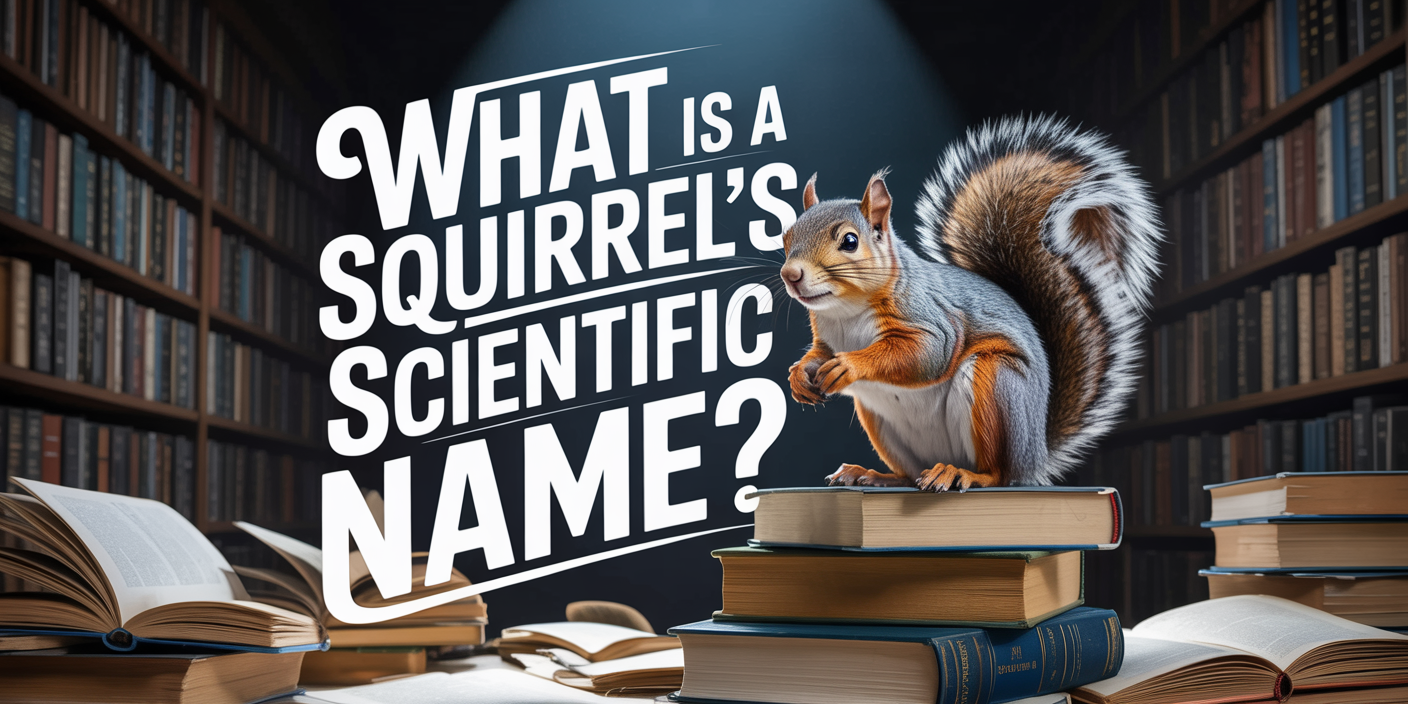“The most common squirrel in Treasure Coast, FL is the Eastern gray squirrel, scientifically named Sciurus carolinensis. You’ll often find them in neighborhoods, parks, and even attics across the region.“
Squirrels are some of the most familiar wildlife you’ll spot in backyards, parks, and forests across the country, but have you ever wondered what their official scientific name is? While “squirrel” is the casual term we all use, these energetic, bushy-tailed animals belong to a much broader biological classification.
Understanding their scientific name helps break down how they fit into the animal kingdom and gives insight into the different types of squirrels we see, from the ones leaping through tree branches to those burrowing underground. If you’re dealing with an unexpected visitor in your attic or yard, AAAC Wildlife Removal specializes in expert squirrel removal to keep your property safe.
The scientific name for the squirrel family is Sciuridae, a term that covers over 200 species including tree squirrels, ground squirrels, flying squirrels, and chipmunks. Each group within that family has its own specific genus and species name depending on its traits and habitat.
For example, the common gray squirrel found in North America is known as Sciurus carolinensis. So, while “squirrel” might sound simple, the science behind their names is surprisingly diverse and detailed. And when these critters get too close for comfort, calling AAAC Wildlife Removal for professional squirrel removal is the smart move.
Learn more: What does “squirrel” mean in slang?
What is a Squirrel’s Scientific Name?
Eastern Gray Squirrel: Sciurus carolinensis
Squirrels belong to the family Sciuridae, which includes many different species across North America. In Treasure Coast, the most common squirrel you’re likely to encounter is the Eastern gray squirrel, with the scientific name Sciurus carolinensis.
These squirrels are medium-sized, grayish with white underbellies, and are known for nesting in attics, soffits, and tree canopies throughout suburban neighborhoods. Eastern gray squirrels are highly adaptable and thrive in both wooded areas and residential zones from Fort Pierce to Port St. Lucie.
Their population density and bold nature make them the top culprits in home invasions and property damage, especially during nesting season. Identifying them correctly helps ensure the right removal and exclusion approach is taken from the start.
Other Florida Squirrels: Sciurus niger and Glaucomys volans
Treasure Coast is also home to the fox squirrel (Sciurus niger), which is much larger and has a mix of black, brown, and orange coloring. These squirrels prefer pine forests and rural spaces but will occasionally be spotted near golf courses or larger residential lots with mature trees.
Though less common than gray squirrels, their burrowing and chewing habits can still cause serious issues if they settle close to your home. Another notable species is the Southern flying squirrel, or Glaucomys volans.
Unlike their name suggests, these squirrels don’t truly fly, they glide using a special membrane between their limbs. They’re small, nocturnal, and often go unnoticed until signs of infestation appear. Their presence in attics often requires more specialized removal since they’re more elusive and federally protected in some areas.
Why Should You Know the Scientific Name?
Better Identification for Humane Removal
Knowing a squirrel’s scientific name helps wildlife professionals identify the exact species and apply the most effective, humane removal techniques. For example, Sciurus carolinensis (Eastern gray squirrel) often nests in attics and chimneys, while Glaucomys volans (Southern flying squirrel) might require nighttime inspections due to their nocturnal habits.
Each species behaves differently, so correct identification ensures faster, safer, and regulation-compliant removal. At AAAC Wildlife Removal of Treasure Coast, we use scientific classification as part of our inspection and planning process.
It’s not just about removing squirrels, it’s about understanding their biology so we can relocate them without harm and prevent them from coming back. Proper identification also avoids the risk of disturbing protected or less common species in the area.
Prevention Strategies Depend on the Species
The scientific name also tells you a lot about a squirrel’s habits, territory, and vulnerabilities, which directly influence your prevention strategy. Eastern gray squirrels, for instance, often chew through fascia boards and wires, so sealing roof gaps and trimming trees is essential.
On the other hand, flying squirrels need attic ventilation screens and tighter exclusion work due to their small size and gliding ability.
If you’re dealing with recurring issues in areas like Palm City or Jensen Beach, knowing which species is causing the damage can save time and money. Each removal plan AAAC Wildlife Removal executes is tailored by species to ensure long-term protection for your home. That’s the power of starting with the correct scientific name.
Where Are Squirrels Most Common in the Treasure Coast Area?
Hotspots for Squirrel Activity
Squirrels are everywhere in the Treasure Coast, but some neighborhoods tend to attract more activity than others. Areas like Port St. Lucie, Palm City, and Vero Beach; with their tree-lined streets, parks, and older homes, offer ideal nesting conditions.
These environments provide easy access to food, shelter, and nesting materials, which makes them prime targets for squirrel invasions. Local homes with attic ventilation gaps, open chimneys, or overhanging tree branches are especially vulnerable.
Once a squirrel finds a way in, they can quickly set up a nest and start causing damage. At AAAC Wildlife Removal, we often receive calls from homeowners in these areas reporting scratching sounds, chewed wires, and droppings in the attic.
Seasonal Behavior and Nesting Patterns
Squirrel activity on the Treasure Coast tends to spike in early spring and late fall. These are the primary nesting seasons, and it’s when female squirrels search for safe, warm places to raise their young, often inside residential attics.
During these times, it’s common to see more aggressive behavior, including digging or chewing to gain access to your roofline. The warm, humid climate in the region means squirrels don’t face the same survival pressures as in colder states, so they stay active nearly year-round.
That’s why consistent monitoring and prevention are key. Understanding where and when squirrels are most active helps AAAC Wildlife Removal act quickly and keep infestations from growing out of control.
What to Do If You See Squirrels Around Your Home?
Common Signs of a Squirrel Infestation
If you’re hearing scratching or scampering sounds during the day, especially in the early morning or late afternoon, there’s a good chance squirrels have moved in. Other warning signs include chewed electrical wires, torn insulation, droppings in your attic, or visible entry holes along your roofline.
You might also spot them frequently darting across power lines or leaping from trees to your rooftop. These signs should never be ignored, as squirrels can cause costly structural damage and even start fires by gnawing on live wires.
In Treasure Coast communities like Stuart or Fort Pierce, where wildlife frequently overlaps with residential zones, early detection is everything. The sooner you identify these issues, the easier it is to avoid long-term repairs and keep your home safe.
Safe and Effective Removal with AAAC Wildlife Removal
Once you’ve confirmed squirrel activity, it’s important to act quickly and avoid DIY methods that can harm the animal or make the problem worse. At AAAC Wildlife Removal, we provide humane trapping, exclusion, and cleanup services that comply with Florida wildlife laws.
We tailor each removal plan to the species; whether it’s a flying squirrel, fox squirrel, or gray squirrel, to ensure safe and legal relocation. We also inspect for future vulnerabilities, seal all potential entry points, and recommend habitat modifications to keep squirrels from returning.
With years of experience serving the Treasure Coast, our team understands the local environment and the specific squirrel species that call it home. Protecting your property starts with calling in pros who know how to handle the problem from every angle.
Pro Tip: Squirrel Problems? Don’t Wait Until Damage Gets Worse
Squirrels may look harmless, but once they’ve broken into your attic, the damage can add up fast. From chewed insulation and gnawed wiring to contaminated air ducts and nesting debris, a small squirrel problem can snowball into a full-blown property risk.
In warm, active regions like the Treasure Coast, squirrels reproduce quickly and can return if even the smallest access point is left unsealed. That’s why prompt action is critical. At AAAC Wildlife Removal, we don’t just remove the problem, we prevent it from coming back.
Our licensed specialists inspect your home from roofline to foundation, close off entry points, and help you protect your home long-term using safe, proven methods tailored to our local squirrel species.
Why Knowing Squirrel Species Matters for Lasting Control?
Understanding a squirrel’s scientific name might seem like a fun fact, but in reality, it’s a powerful tool for proper wildlife management. Knowing whether you’re dealing with Sciurus carolinensis, Sciurus niger, or Glaucomys volans helps guide the right removal strategy, from timing to techniques.
For Treasure Coast homeowners, this knowledge can mean the difference between a quick fix and recurring infestations. At AAAC Wildlife Removal of Treasure Coast, we combine species-specific expertise with local insight to deliver effective, humane squirrel control.
If you’ve seen signs of squirrel activity, or just want peace of mind, reach out to our team for a full inspection. We’re here to protect your home, your wiring, and your sanity from these furry intruders.
Call AAAC Wildlife Removal Today!
Don’t let squirrels turn your home into their personal nesting ground. If you’re hearing strange noises, seeing chewed wires, or spotting squirrels on your roof, it’s time to call in the experts. AAAC Wildlife Removal of Treasure Coast offers fast, humane, and professional squirrel control services designed to keep your home safe and wildlife-free.
Our team knows the local species, understands Florida’s wildlife laws, and gets the job done right the first time. Schedule your free inspection today and take the first step toward lasting protection. Call now or book online, we’re ready when you are!




